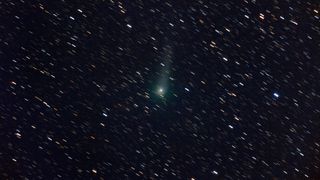A megacomet glows in the dim in this lengthy-exposure graphic captured by an astrophotographer on June 18, before its closest tactic to Earth.
Comet C/2017 K2 (PANSTARRS), identified as K2, will swing by our earth on Wednesday (July 13) nearly twice as far away from Earth as our planet is from the sunshine. But the comet, which may well be much as 100 miles (160 kilometers) vast, is however spewing more than enough dust to display in the watch of telescopes.
“Seem for a six-inch coma,” suggested John Chumack of galacticimages.com (opens in new tab), who observed the large comet in the constellation Ophiuchus from a dim locale in Yellow Springs, Ohio. (A coma is the cloud of gas and dust a comet shoots out as the sun warms its floor and will cause particles and molecules to rise into area.)
Connected: Huge comet was active way farther from the sunshine than anticipated, experts verify
At the time Chumack photographed the comet, it was at the celestial equator in constellation Ophiuchus. It was obvious in equally a six-inch reflector and an 8-inch Schmidt-Cassegrain telescope, he added.
But the natural beauty shot came from a a little bit greater 12-inch F4 Newtonian reflector, Chumack included. Other products involved in the 31-moment exposure included a Bisque ME mount and a modified Canon 6D DSLR digicam.
Chumack approximated K2 had a magnitude of 9.7 when he caught it on digicam, and EarthSky (opens in new tab) estimates the comet may possibly get as brilliant as magnitude 7 by the conclusion of 2022. By comparison, magnitude 6 is about the dimmest stars readily available to your bare eye, even though the comet would be extra tricky to see as it is diffuse.
If you might be on the lookout for binoculars or a telescope to see the comet in the evening sky, check out out our manual for the best binocular deals and the best telescope bargains now. If you require gear to seize the minute, look at our guides for the best cameras for astrophotography and the best lenses for astrophotography to make guaranteed you are all set for the future comet sighting.
Editor’s Observe: If you snap a photograph of the comet and would like to share it with Area.com’s audience, send out your photograph(s), responses, and your title and place to [email protected].
Adhere to Elizabeth Howell on Twitter @howellspace (opens in new tab). Observe us on Twitter @Spacedotcom (opens in new tab) and on Fb (opens in new tab).
